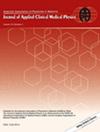Practical experience in commissioning ring applicators using ring applicator component type with bravos control software v1.2
Abstract
Purpose
The Bravos v1.2 control software introduces a ring applicator component type (ACT) with channel length verification to address geometric characteristics and dosimetric discrepancies caused by source positioning inaccuracies. This study aims to commission the ring applicator and investigate the new ring ACT in Bravos 1.2.
Material and methods
We evaluated two commissioning methods for a CT/MRI-compatible titanium ring applicator across three Bravos afterloaders and compared the new ring ACT with the traditional rigid ACT. Modifications to Varian's standard commissioning method included: (1) Delivering film plans with a 0.5 cm step size instead of 1 cm; (2) Alternating 0.3 s and 1 s dwell positions for enhanced source positioning analysis; (3) Including both “odd” and “even” positions to replicate clinical conditions. Films for 30-, 45-, and 60-degree rings (3.2 cm diameter) were delivered using modified methods and manual offsets of 0.0 cm, 0.1 cm, and 0.2 cm. Discrepancies between delivered and planned positions were analyzed, and the optimal offset was validated using clinical plans. Dosimetric differences for various gross tumor volumes (GTVs) and organs at risk (OARs) were assessed.
Results
Film analysis (216 films) identified 0.2 cm as the optimal offset for all rings and afterloaders, minimizing deviations between the planned and delivered dwell positions. The rigid ACT showed larger discrepancies. The optimal offset reduced physical dosimetric differences to < 1% for key clinical metrics (D95, D90, D2cc) across all angles, with negligible differences in EQD2 values.
Conclusion
A novel commissioning procedure was developed to determine an optimal offset for accurate source positioning and minimize dosimetric discrepancies with the ring ACT. This method improves accuracy compared to the rigid ACT and standardizes commissioning for Bravos afterloaders with the v1.2 control system.


 求助内容:
求助内容: 应助结果提醒方式:
应助结果提醒方式:


